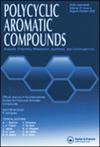Synthesis, Spectral Analysis, DFT Calculations, in Vitro Screening, and Molecular Docking of New Metal Complexes with Quinoline and Isoniazid Schiff Base as Antimicrobial and Antioxidant Agents
IF 2.4
3区 化学
Q2 CHEMISTRY, ORGANIC
引用次数: 0
Abstract
We herein report the synthesis, spectral analysis, DFT calculations, in vitro and in silico biological activities of novel N'-((2-thioxo-1,2-dihydroquinolin-3 yl)methylene)isonicotinohydr-azide with its Cu(II), Co(II), Ni(II), and Zn(II) complexes have been successfully prepared. The ligand and the complexes were characterized by analytical, FT-IR, 1H NMR, mass, UV–visible spectroscopy, molar conductivity, and magnetic susceptibility measurements. Density Functional Theory (DFT) estimations for the ligand at the DFT/B3LYP level via 6-31 G++ (d, p) replicate the structure and geometry. Furthermore, molecular docking and ADME calculations were also performed to correlate and interpret the experimental results. The antimicrobial activity study illustrated enhancement in the activity of the free ligand upon complex formation, and the Cu(II) complex (MIC 25 µg mL−1) may be considered a promising antibacterial agent, and Ni(II) and Zn(II) complexes (MIC 25 µg mL−1) as promising antifungal agent. Also, synthesized Ni(II) and Zn(II) metal complexes (MIC 3.125 µg mL−1) showed promising anti-TB activity against Mycobacterium tuberculosis. In the antioxidant activity, the Cu(II) complex showed excellent activity as compared to standard drugs and in silico docking studies were carried out against Cytochrome c Peroxidase (PDB ID: 2X08).

作为抗菌剂和抗氧化剂的喹啉和异烟肼席夫碱新金属配合物的合成、光谱分析、DFT 计算、体外筛选和分子对接
我们在此报告成功制备了新型 N'-((2-硫酮-1,2-二氢喹啉-3 yl)亚甲基)异烟肼及其铜(II)、钴(II)、镍(II)和锌(II)配合物的合成、光谱分析、DFT 计算、体外和硅学生物活性。通过分析、傅立叶变换红外光谱、1H NMR、质量、紫外可见光谱、摩尔电导率和磁感应强度测量,对配体和配合物进行了表征。在 DFT/B3LYP 水平上,通过 6-31 G++ (d, p) 对配体进行了密度泛函理论(DFT)估算,复制了其结构和几何形状。此外,还进行了分子对接和 ADME 计算,以关联和解释实验结果。抗菌活性研究表明,自由配体在形成配合物后活性增强,Cu(II) 配合物(MIC 25 µg mL-1)可被视为一种有前途的抗菌剂,Ni(II) 和 Zn(II) 配合物(MIC 25 µg mL-1)可被视为一种有前途的抗真菌剂。此外,合成的 Ni(II) 和 Zn(II) 金属配合物(MIC 3.125 µg mL-1)对结核分枝杆菌也显示出良好的抗结核活性。在抗氧化活性方面,与标准药物相比,Cu(II) 复合物显示出卓越的活性,并针对细胞色素 c 过氧化物酶(PDB ID:2X08)进行了硅对接研究。
本文章由计算机程序翻译,如有差异,请以英文原文为准。
求助全文
约1分钟内获得全文
求助全文
来源期刊

Polycyclic Aromatic Compounds
化学-有机化学
CiteScore
3.70
自引率
20.80%
发文量
412
审稿时长
3 months
期刊介绍:
The purpose of Polycyclic Aromatic Compounds is to provide an international and interdisciplinary forum for all aspects of research related to polycyclic aromatic compounds (PAC). Topics range from fundamental research in chemistry (including synthetic and theoretical chemistry) and physics (including astrophysics), as well as thermodynamics, spectroscopy, analytical methods, and biology to applied studies in environmental science, biochemistry, toxicology, and industry. Polycyclic Aromatic Compounds has an outstanding Editorial Board and offers a rapid and efficient peer review process, as well as a flexible open access policy.
 求助内容:
求助内容: 应助结果提醒方式:
应助结果提醒方式:


